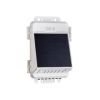HOBO Electronic Switch Pulse Input Adapter
Features
- Plug-n-play adapter for pulse output sensors
- Automatically recognized by H21, U30, RX2100 & RX3000 stations
- Compatible with FET or open-collector outputs
- Expedited repair and warranty service
- Lifetime technical support
- More
The Electronic Switch Pulse Input Adapter connects sensors with pulse outputs to data loggers with smart-sensor inputs. This Smart Sensor is compatible with electronic switch closures such as FET or open-collector outputs, or CMOS-level logic signals with a maximum input frequency of 120 Hz (120 pulses per second).
Maximum input frequency: 120 Hz (120 pulses per second)
Measurement range: 0 – 65,533 pulses per logging interval
Resolution: 1 pulse
Lockout time: 45 µs ± 10%
Recommended input type: Electronic solid state switch closure or CMOS-level digital output (example: FET, opto-FET or open collector)
Preferred switch state: Active low input Normally open
Edge detection: Falling edge, Schmitt Trigger buffer (logic levels: low ≤ 0.6 V, high ≥ 2.7 V)
Minimum pulse width: 1 ms
Input/output impedance: 100 KΩ
Open circuit input voltage: 3.3 V
Maximum input voltage: 3.6 V
User connection: 24 AWG wires, 2 leads: white(+), black(-)
Operating temperature range: -40° to 75°C (-40° to 167°F)
Overall cable length: 1 m (3.3 ft.)
Housing: Weatherproof PVC housing protects input adapter electronics
Housing dimensions: 14 x 0.95 cm (5.5 x 0.375 in.)
Weight: 310 g (11 oz.)
Bits per sample: 16
Number of data channels: 1
Measurement averaging option: No (reports the number of pulses over the logging interval)
In The News
From Paddles to Phytoplankton: Studying Vermont’s Wildest Lakes
For six months of the year, Rachel Cray, a third-year PhD student at the Vermont Limnology Laboratory at the University of Vermont, lives between a microscope and her laptop, running data. For the other six months, she is hiking and canoeing four of Vermont’s lakes, collecting bi-weekly water samples. Cray studies algal phenology across four lakes in Vermont, US, that have low anthropogenic stress—or in other words, are very remote. Funded by the National Science Foundation Career Award to Dr. Mindy Morales, the lakes Cray researches part of the Vermont Sentinel Lakes Program, which studies 13 lakes in the area and, in turn, feeds into the Regional Monitoring Network, which operates in the Northeast and Midwest US.
Read MoreReimagining Water Filtration: How Monitoring and Science Enhance FloWater Filtration Systems
Over 50% of Americans think their tap water is unsafe , according to the Environmental Working Group (EWG). Other recent surveys have found that number to be as high as 70% of persons surveyed. Whether due to increased public awareness of water quality issues or confusion about how municipal water sources are regulated, there is a clear distrust of tap water in the United States. According to industry expert Rich Razgaitis, CEO and co-founder of the water purification company FloWater, this issue creates a damaging cycle. Razgaitis explained that the health and environmental problems associated with contaminated water aren’t the only issues. As people become increasingly aware that some tap water is unsafe, they resort to bottled water.
Read MoreMonitoring New Hampshire’s Aquatic Ecosystems: Continuous Data Collection in the Lamprey River Watershed
New Hampshire’s aquatic ecosystems provide a range of ecosystem services to the state and region. Resources and services like clean water, carbon storage, climate regulation, nutrient regulation, and opportunities for recreation all depend on New Hampshire’s aquatic ecosystems remaining healthy. Jody Potter, an analytical instrumentation scientist at the University of New Hampshire (UNH), is studying these aquatic ecosystems in hopes of developing an improved understanding of ecosystem services and their interactions with climate change, climate variability, and land use changes. [caption id="attachment_39799" align="alignnone" width="940"] Aquatic sensors in the Merrimack River in Bedford, NH, with I-293 in the background.
Read More

















